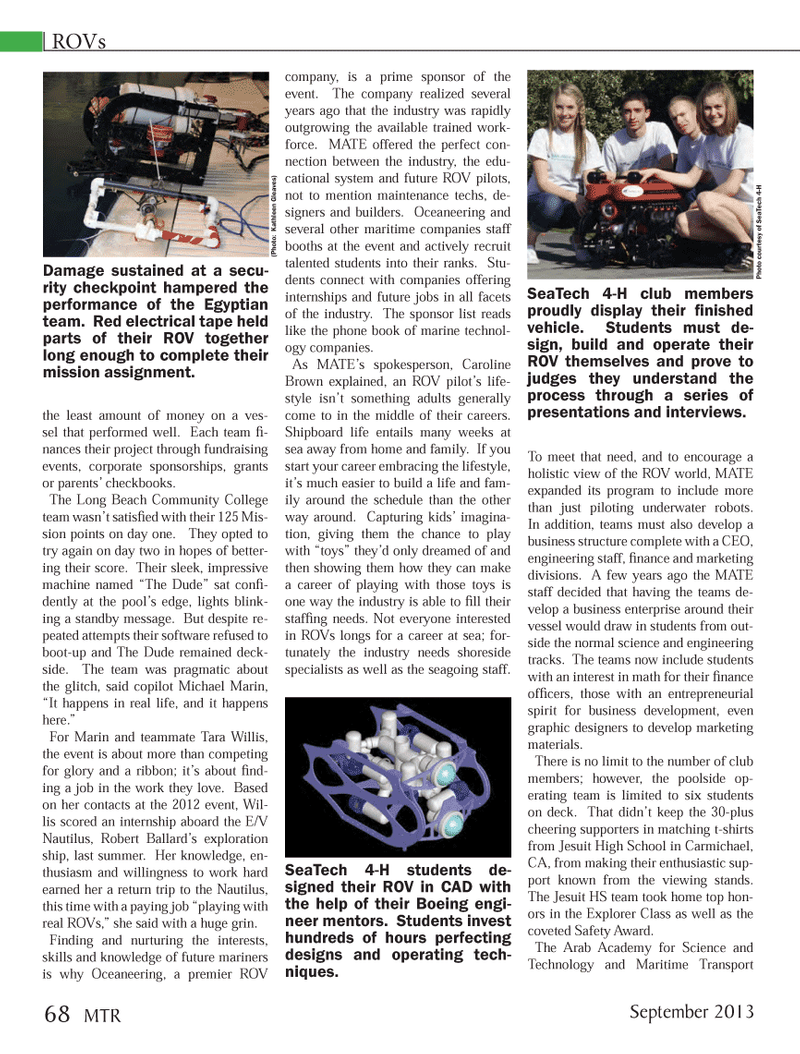
Page 68: of Marine Technology Magazine (September 2013)
Ocean Observation: Gliders, Buoys & Sub-Surface monitoring Networks
Read this page in Pdf, Flash or Html5 edition of September 2013 Marine Technology Magazine
the least amount of money on a ves- sel that performed well. Each team Þ -nances their project through fundraising events, corporate sponsorships, grants or parentsÕ checkbooks. The Long Beach Community College team wasnÕt satisÞ ed with their 125 Mis- sion points on day one. They opted to try again on day two in hopes of better- ing their score. Their sleek, impressive machine named ÒThe DudeÓ sat conÞ -dently at the poolÕs edge, lights blink- ing a standby message. But despite re-peated attempts their software refused to boot-up and The Dude remained deck- side. The team was pragmatic about the glitch, said copilot Michael Marin, ÒIt happens in real life, and it happens here.Ó For Marin and teammate Tara Willis, the event is about more than competing for glory and a ribbon; itÕs about Þ nd-ing a job in the work they love. Based on her contacts at the 2012 event, Wil- lis scored an internship aboard the E/V Nautilus, Robert BallardÕs exploration ship, last summer. Her knowledge, en- thusiasm and willingness to work hard earned her a return trip to the Nautilus, this time with a paying job Òplaying with real ROVs,Ó she said with a huge grin. Finding and nurturing the interests, skills and knowledge of future mariners is why Oceaneering, a premier ROV company, is a prime sponsor of the event. The company realized several years ago that the industry was rapidly outgrowing the available trained work- force. MATE offered the perfect con- nection between the industry, the edu- cational system and future ROV pilots, not to mention maintenance techs, de-signers and builders. Oceaneering and several other maritime companies staff booths at the event and actively recruit talented students into their ranks. Stu-dents connect with companies offering internships and future jobs in all facets of the industry. The sponsor list reads like the phone book of marine technol- ogy companies.As MATEÕs spokesperson, Caroline Brown explained, an ROV pilotÕs life- style isnÕt something adults generally come to in the middle of their careers. Shipboard life entails many weeks at sea away from home and family. If you start your career embracing the lifestyle, itÕs much easier to build a life and fam- ily around the schedule than the other way around. Capturing kidsÕ imagina- tion, giving them the chance to play with ÒtoysÓ theyÕd only dreamed of and then showing them how they can make a career of playing with those toys is one way the industry is able to Þ ll their stafÞ ng needs. Not everyone interested in ROVs longs for a career at sea; for- tunately the industry needs shoreside specialists as well as the seagoing staff. To meet that need, and to encourage a holistic view of the ROV world, MATE expanded its program to include more than just piloting underwater robots. In addition, teams must also develop a business structure complete with a CEO, engineering staff, Þ nance and marketing divisions. A few years ago the MATE staff decided that having the teams de- velop a business enterprise around their vessel would draw in students from out- side the normal science and engineering tracks. The teams now include students with an interest in math for their Þ nance ofÞ cers, those with an entrepreneurial spirit for business development, even graphic designers to develop marketing materials. There is no limit to the number of club members; however, the poolside op- erating team is limited to six students on deck. That didnÕt keep the 30-plus cheering supporters in matching t-shirts from Jesuit High School in Carmichael, CA, from making their enthusiastic sup-port known from the viewing stands. The Jesuit HS team took home top hon-ors in the Explorer Class as well as the coveted Safety Award. The Arab Academy for Science and Technology and Maritime Transport ROVs Damage sustained at a secu- rity checkpoint hampered the performance of the Egyptian team. Red electrical tape held parts of their ROV together long enough to complete their mission assignment.SeaTech 4-H students de- signed their ROV in CAD with the help of their Boeing engi-neer mentors. Students invest hundreds of hours perfecting designs and operating tech- niques.SeaTech 4-H club members proudly display their Þ nished vehicle. Students must de- sign, build and operate their ROV themselves and prove to judges they understand the process through a series of presentations and interviews. (Photo: Kathleen Gleaves) Photo courtesy of SeaTech 4-H September 201368 MTRMTR #7 (66-81).indd 68MTR #7 (66-81).indd 688/23/2013 9:07:46 AM8/23/2013 9:07:46 AM

 67
67

 69
69
